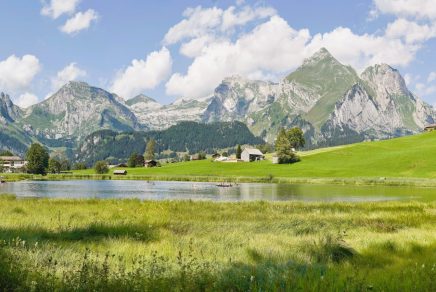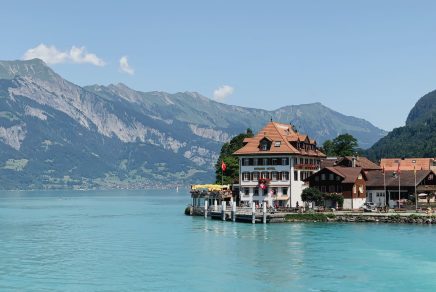Switzerland’s land area may be just one 26th of Ontario’s, yet it boasts 26 cantons, 4 official languages, and numerous gastronomic specialties with diverse influences. Yes, it’s the country of cheese and chocolate. But what else?
Chocolate
Chocolate alone would be reason enough to visit Heidi’s homeland, wouldn’t it? It’s impossible not to mention it! While the artisanal creations of Philippe Pascoët in Carouge remain some of our most cherished memories, the popular chocolatier Martel, with numerous outlets throughout the country, has also provided us with delightful moments of ecstasy. Chocolate can sometimes be found in unexpected places, such as in the sauce that accompanies the beef at the Zunfthaus zu Wirthen in Solothurn.
By the way, did you know that there’s a chocolate train that takes you to Gruyères, where the Cailler chocolate factory is located?
Gruyère Cheese
No, Gruyère doesn’t have holes! It’s Emmental, thanks to the fermentation process. Swiss Gruyère is protected, so you’ll often see “Gruyère AOC” for “appellation d’origine contrôlée”.
In Gruyères, La Maison du Gruyère will tell you all there is to know about this iconic cheese. While you’re there, stop by the restaurant and try all sorts of cheese-based dishes! By the way, did you know that only the town of Gruyères is spelled with an “s”?
Raclette
Cheese lovers, welcome to paradise! Here, cheese is literally grated and eaten with potatoes, onions and gherkins.
For an unforgettable raclette, try the one at the Château de Villa in Sierre, Valais. It should be accompanied by a glass of Fendant, a white wine that goes perfectly with this typical dish! During our visit, we tasted five cheeses from different origins: Bagnes 8 (Lourtier), Bagnes 1 (Verbier), Vissoie, Simplon and Gomser 55 (Grengiols).
Looking for the best raclette cheese? The tasting dairy in Turtmann has won the Swiss championship several times.
Cheese Fondue
More cheese? Yes, and there’s no end in sight! Do you prefer Vacherin fondue, like the people of Fribourg, or the half-and-half with Gruyère? With bread or potatoes? One thing’s for sure: you can’t go to Switzerland without trying this classic! The one at La Maison du Gruyère is delicious.
Rösti
According to Switzerland Tourism, Rösti was originally “the traditional breakfast of the Swiss-German farmers”. Today it’s a national dish eaten all over the country. But each region has its own version. Bernese, for example, prefer their rösti with crispy butter. Not exactly a light meal!
Wine
Wine is grown in every canton in Switzerland. So why are Swiss wines less well known on this side of the Atlantic? Simply because they don’t produce enough to export. In Valais, for example, there are 15,000 winegrowers and 110 grape varieties. “We can’t mechanise the vines here, everything is done by hand,” explains Joël Briguet of the La Romaine winery. With high production costs, the focus is on premium wines, as it would be impossible to compete with cheap imported wines.
Typical Valais wines include Fendant (Chasselas), Petite Arvine (a renowned white wine) and Cornalin, Valais’ finest red wine.
Among the country’s most beautiful landscapes are the terraced vineyards of Lavaux, near Lausanne, which seem to plunge into Lake Geneva. And yes, there’s good wine to drink too!
Double Cream
Not tasting double cream is like turning up your nose at maple syrup in Quebec. It’s undoubtedly one of Switzerland’s most exquisite delicacies, and one of the least known. Untouched by processing, double cream has an infinitely smooth texture. Admittedly, its 40 to 45% fat content won’t make you feel good about all the cheese and chocolate you’ve been eating. But it’s so delicious! Enjoy it with strawberries and wood-fired meringue.
Älplermagronen or Mountain Macaroni
This rich macaroni dish with potatoes, bacon, cheese and cream is served with apple sauce. It tastes even better after a hike in the Alps, with snow-capped peaks as a backdrop. Yes, this is a long way from Kraft Dinner…
Fribourg Bricelet
Thin, sometimes flat, sometimes rolled, the Fribourg bricelet is a cross between a waffle and a biscuit. It is said to have been around since 1552. Either way, it’s just as delicious today!
Grisons Meat
This air-dried beef, seasoned with salt, alpine herbs and spices, was once made to be eaten in winter. Nowadays it’s enjoyed all year round, even in Canada, where a small part of the production is exported.
Of course, each region has its own typical charcuterie! In the Valais, we particularly enjoyed the specialities of the Boucherie des Landes, the raw ham from the Meyer butcher’s shop and the dry bacon from Salaison d’Anniviers. Still hungry?






